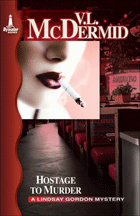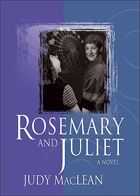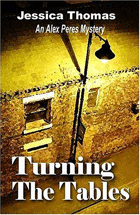• Course of Action • Hostage to Murder • Rosemary and Juliet • Turning the Tables
Arlene Germain is a former English teacher who currently lives in Massachusetts. She is a book reviewer for The Lambda Book Report [www.lambdalit.org], the Golden Crown Literary Society newsletter, The Crown, [www.goldencrown.org], the Midwest Book Review [www.midwestbookreview.com], and the Just About Write Newsletter [www.justaboutwrite.com].
Like any reviewer, I am sure that she would like to hear from you—either your thoughts on her review, or to submit a book to her for review in future issues of IGW. You can contact her, here.
 Course
of Action
Course
of ActionBy Gun Brooke
Bold Strokes Books
ISBN: 1-933110-22-8
Paperback
$15.95
320 pages
Take one desperately determined middle-aged diva from Tinseltown and add one mysterious, megabucks publisher and philanthropist from Miami. Stir in personality clashes, ethical conflicts, and a slowly simmering discovery of desire and romantic awakening. What results is Gun Brooke’s refreshing novel, Course of Action. Carolyn Black wants the role of a lifetime, transforming the popular lesbian criminal investigator Diana Maddox from the pages of the popular novel series to the big screen. Annelie Peterson owns the film rights and wants to interview and audition several actresses for the role. However, at the same time, Annelie possesses a secret or two when it comes to Carolyn Black, secrets better left undisclosed for the moment. These two likable career women have indeed found a worthy and challenging adversary in each other. Carolyn and Annelie are vibrant and charismatic women, but they are far from the carefully crafted public persona each willingly reveals to the world. Corporate machinations, Hollywood hype, family crises, and intriguing secondary characters all intersect to create varied conflicts, some of which appear to have no easy resolutions. Yet, beneath all the clever maneuverings and seemingly shady shenanigans, a relationship is being forged, but whether or not it is genuine, Carolyn and Annelie must discover for themselves.
Brooke has created an appealing set of circumstances. Finding the right actress to play the role of Diana Maddox so as not to disappoint the many fans of the fictional detective is the main premise of the book. The disparate characters each have a stake in seeing this project come to fruition. It is the discord that arises from this quest that provides the reader with a fast-paced reading experience. The plot flows naturally and uncluttered from one scene to the next. The various sub-plots are written in a contained yet expansive manner. The author has an easy comfortable writing style, and chapters are often marked by several scene breaks within the chapter. This device succeeds in rapidly driving the plotline; the reader’s interest is piqued with every new scene.
A well-written novel has a strong and memorable opening, and Course of Action delivers. “That role is mine! I am Diana Maddox” (page 11)! With the exclamation of those eight simple words, the reader meets the whirlwind, Carolyn Black. Part of the pleasure in this book is determining if she indeed is the larger-than-life diva she purports to be. From the very outset the reader wonders if the reticent Annelie is also what she seems to be. Therein lays the basic contention for the reader to resolve along with these two women. The foreshadowing presented here is fairly elementary, but at the same time, it is intriguing for the reader to see if her expectations occur.
The setting created by Brooke is a glimpse into that fantasy world of celebrity and high rollers, escapist to be sure, but witnessing the relationship develop between Carolyn and Annelie is well worth the trip. As the reader progresses, the trappings become secondary to the characters’ desire to reach goals both professional and personal.
Some may find the title a bit misleading, although there is a reference to it, “I guess we’ll have to agree on a course of action before….” (p. 291). However, it certainly doesn’t detract from the overall effect. This reader would have preferred a few loose ends be more tightly wrapped up, but, then again, that is the usual basis for a sequel, and Brooke has created a workable segue should she decide to continue. Course of Action is a commendable effort in the romance genre. The novel is populated with a host of captivating and amiable characters. The glimpses into the lifestyles of the rich and beautiful people are rather like guilty pleasures. The overall result makes for a most satisfying and entertaining reading experience.
 Hostage
to Murder
Hostage
to MurderBy Val McDermid
Bywater Books
ISBN: 1-932859-02-0
Paperback
$12.95
240 pages
Originally published in 2003 in the UK, Hostage to Murder by Val McDermid is now released in America; it is the latest installment in her lesbian mystery series featuring journalist Lindsay Gordon. After having spent the last seven successful and happy years living and working in California, thirty-nine year-old Lindsay has returned to her native Scotland and now feels, “…that this long narrow land was no longer full of possibilities for her” (p. 3). Having returned to advance the medical career of her physician lover, Sophie Hartley, serves only to remind Gordon that she has nothing going for her in her own professional world. Making matters even worse is Sophie’s ceaseless obsession about having a child—with or without Lindsay who is indeed having second, third, and fourth thoughts about parenthood. While out jogging one morning, Lindsay careens into Rory McLaren, a late twenty-something independent investigative journalist. After a brief discussion in her flat while tending to Lindsay’s sprained ankle, Rory offers her an opportunity to get back into the world of reporting. Upon returning home and once again feeling the pressures of Sophie’s maternal desire, Lindsay decides to give it a go. Continuing trouble on the domestic front, tantalizing temptation from her young boss, and refusing to allow Sophie to support her, all contribute to Lindsay’s decision. Kidnapping, IRA terrorists, Russian intrigue, and ticking biological clocks serve to further complicate the situation, enhance the action, and require many of the characters to re-evaluate their lives.
Compared to the other books in McDermid’s series, Hostage to Murder delves into the basic insecurities of the heroine, her flaws, and the unsettling truths of three people who want very different things from life and each other. The methods of characterization are technically very well drawn here. As seen through their actions and speech, there are really no villains here, except for those who drive the mystery. This book is much more of a study of what makes people tick, and most importantly, how very compelling and far-reaching individual choices cast forth sometimes irretrievable consequences. Lindsay Gordon is pushing forty, perhaps at the crossroads of the proverbial mid-life crisis, and she has been shown “…a bewildering new side to her own sexuality, both scary and magical. But wrong was one thing it hadn’t felt” (p. 127).
The degree of writing excellence displayed in the author’s use of tone and mood was most appreciated by this reader. Too often a writer gives one or both short shrift. From the somber freezing drizzle of Scotland to the almost feudal-like state of present-day St. Petersburg, the reader is enveloped by the sights and sounds of each place, immersed in the atmosphere of the various locales, and thoroughly rooted within the action. This is a darker, edgier novel than other series books; the desperation and confusion of several of the characters is almost palpable. In some ways McDermid uses these backdrops to counterbalance the characters’ emotional state, especially that of Lindsay.
Rory McLaren is an attractive, charming, and provocative young woman. She may appear to be star struck when in the presence of the Lindsay Gordon, reporter extraordinaire, but Rory is a solid freelance investigative journalist who performs her job a bit on the unorthodox side, but she is equal to any and all comers. On a personal level, Rory exudes swagger and aplomb. However, the reader soon perceives the woman beneath the veneer. A glib self-described love ‘em and leave ‘em type while talking to her friend Sandra, the private Rory has serious relationship issues which continue to plague her as she nears thirty. However, as she begins to work with Lindsay, Rory suspects and dares to conjecture that her natural misgivings may be about to change. In fact, it is Rory who delivers one of the more memorable lines in lesbian literature. When Sophie tells her that Lindsay is lucky to have her for a friend and that it is more than Lindsay deserves, Rory flashes a smile and responds with, “We’re both more than she deserves. And also rather less” (p. 238). Rory has succinctly stated the thematic chord which plays throughout the narrative.
Hostage to Murder is an excellent book on so very many levels, and it is due to this multiplicity of meanings that captivates a wide range of readers. McDermid has written a mystery which is carefully layered and delineated. This reader has read the entire Gordon series. However, this final visit with Lindsay as she grapples with life’s conundrums is, by far, the most rewarding. McDermid has moved on to writing more mainstream, that is, straight novels and series. This reviewer would appreciate seeing her return to her roots, her initial core audience, by penning another book in the series.
 Rosemary
and Juliet
Rosemary
and JulietBy Judy MacLean
Alice Street Editions, Harrington Park Press
ISBN: 1-56023-483-0
Paperback
$17.95
265 pages
Judy MacLean’s freshman novel, Rosemary and Juliet, spins a tale of young love and sexual awakening for two compelling and personable teenage girls from very disparate families. One’s mother and the other’s father could not be more diametrically opposed parents. Romey Arden, a high school junior, is an out and proud lesbian who makes no apologies for who she is. Her supportive mother, Janis, is staunchly pro-choice who operates a woman’s health clinic in the neighboring town. Janis is very much her own woman who is on the frontlines protesting for social justice. Julie Wright is the charming and obedient fourteen year-old daughter of the local fundamentalist minister of the Divido Bible Church. She is a stellar singer in the church choir and is sincerely immersed in both her religious belief and her family’s commitment to the community. However, once she and Romey meet at a carnival, their mutual attraction is undeniable. Romey understands it for what it is, lesbian attraction, but naive Julie can only define it with her word for her overpowering feelings and fantasies, the Yearning. Eventually their relationship is discovered by Julie’s father who is consumed by the potential for sin and damnation for his child. Reverend Wright engages the services of a Dr. Oberholzer. “What I offer is a Christian treatment method” (p. 148). This regimen involves electronic aversive stimulus, more commonly known as electric shock treatment. The Reverend eagerly accepts this diagnostic tool, and he and his wife hope for the best as their modest savings plummet to pay for this procedure. Add to the mix, more than a few homophobic townspeople, several intolerant and violent teenagers, an unexpected death, and well-meaning parents who believe they are doing the right thing, and you have a novel which explores the plight of gay teenagers who are trying to find their place in the world.
MacLean has a straightforward style of writing; the pacing makes it a very readable book. Borrowing from Shakespeare the play-on-words of the title and the overall thematic supposition of inter-familial rancor and animus, she manages to create a contemporary and cautionary narrative, one which parents of gay and straight teenagers would find enlightening. Creating subtle yet captivating characterizations, the author manages to engage the reader on several levels. There are a few flat stereotypical characters, Elliot the flamboyant gay friend and Nick the closeted cousin, but even they seem to strike an occasional chord of credibility. Romey, perhaps, best exemplifies what it means to be a gay and self-respecting student amidst the bigoted loathing found in a typical high school. She has acknowledged her identity and has been blessed with an accepting and loving parent. Romey is a character the reader immediately finds appealing and grows to admire throughout the course of the book. Julie depicts the genuine confusion and dismay of a sincerely religious young girl trying to come to terms with what she has been taught and what she feels cannot be evil. “Nothing can ever happen to me that will make me sorry I loved you” (p. 246). This reader would have preferred that the Julie character had been a year or two older, but the intrinsic uncertainty of self and loving she displays is possible. The dialogue flows easily, the action scenes are energized, and the plot has enough twists and turns to keep the reader intrigued. The themes of homophobia, hate-mongering, and senseless violence are conveyed in a deft and thought-provoking manner. MacLean possesses a keen eye and ear for that age group and her teenagers represent plausible people. It is especially compelling to explore the quandary in which Julie finds herself. Julie’s love for her parents and her belief system juxtaposed with her developing and then escalating questioning of faith is masterfully told.
MacLean’s choice of setting enhances the reality of the story. The girls’ small town of Divido serves as a microcosm of the current state of affairs in this country. Even the town name, Divido, implies a form of division. The on-going struggles between the entrenched conservative religious element and the much-maligned gay community are reflected in the fractious relationships found in today’s families, school environments, and community groups.
Rosemary and Juliet is a novel which has been categorized as a young adult book, but this should not deter any reader over the age of eighteen. This novel is one that movingly and passionately demands consideration, discussion, and scrutiny. There are admonitions here to be heeded by everyone, especially by those individuals whose lives are affected by the very subject matter of the story. MacLean’s direct and unvarnished telling of this poignant tale is well worth reading.
 Turning
the Tables
Turning
the TablesBy Jessica Thomas
Bella Books
ISBN: 1-59493-009-0
Paperback
$12.95
229 pages
Jessica Thomas’ second novel, Turning the Tables, offers another enjoyable glimpse into the life and times of thirty-something Alex Peres, the appealing private investigator/nature photographer who resides Provincetown, Massachusetts. The immediate future certainly appears to be fortuitous for Alex when she receives a triple play of good news. Bank vice-president Choate Ellis approves the loan she requested, he wants to purchase several of her photos to be prominently displayed in the bank, and he offers her a job doing background checks on four prospective candidates for the new certified financial planner position at the bank. To celebrate, Alex and Fargo, her canine best friend, make their way toward their favorite watering hole, the Wharf Rat Bar. There she meets her brother, Sonny, a lieutenant on the police force. After sharing his vacation plans with Alex, Alex uses her restraint and invokes their mutual commandment, “Thou shalt not comment upon any of my romantic partners” (p. 15). Later Alex returns home with nothing more on her mind than enjoying the up-coming Halloween festivities, having a little fun, and perhaps, finding some romance. However, the ghosts and ghouls have other plans. A ritualistic murder occurs, and Alex’s friends, Peter and the Wolf, are high on the suspect list. With Sonny out of town, the case falls to Sergeant Mitchell, a young police officer who seems determined to pin the deed on Alex’s friends. Alex hesitantly becomes involved only to be more baffled when a second murder occurs. Just when she thinks her life is back on the right track, life intrudes with all its many complications.
Thomas’ sequel to Caught in the Net is a satisfying and captivating reading experience. Although classified as a mystery, it is much more than a typical detective procedural. This is a character-driven story and this is an important distinction. Thomas has created a cast of unforgettable characters who rise above the stereotypical; these are people who cover the social spectrum of her community. The very amusing and queenly duo of Peter and the Wolf, Harmon the town reprobate, the controversial Rev. Bartles, the arrogantly righteous former chief of police Jared Mather, and her compassionate Aunt Mae are just a few of the memorable and original characters the reader encounters. The author has constructed an atmosphere and tone that readily engages the reader while at the same time maintaining a comfortably languid rhythm. This affords the reader the opportunity to settle in and savor the unusual happenings and the intelligent wry wit which Alex so deftly displays. During the course of her background check for a candidate one morning, she meets Mimi Trinler, the very attractive Dean of Women at the university. “She gave me that smile again, and I felt that in five minutes she knew me better than my closest friend. I almost asked her to have lunch, but nine-fifteen seemed a little early” (p.99). Alex is an emotionally vulnerable woman with a self-admitted dread of relationship permanence. She probably drinks a little too much, considers the lot of mankind much too often, and spoils Fargo unashamedly, but Alex is someone the reader genuinely would welcome and appreciate in her own life.
Turning the Tables is stylishly written. The author’s word choice is both refreshing and vivid. Her use of imagery is exceptional. While taking Fargo for a romp in the woods, Alex notices that “Some of the copper leaves had fallen, but most were still attached, rustling in the light air like the skirts of an Edwardian lady pacing her garden path” (p. 149). While having breakfast with her two suspect friends, she is asked about the murder weapon, a pine table leg, and the sudden appearance of so many of them in town. “Well…we have enough pine legs to put Robert Louis Stevenson and Herman Melville out of business” (p. 167).
Thomas has two distinct and intriguing storylines and manages to neatly bring them together with the addition of another captivating character. The conflicts increase incrementally throughout the narrative, and the resolutions are crafted logically and credibly. It is interesting to note that the reader doesn’t actually read about the violent deaths occurring, but the aftermath of tension and suspense are clearly present because Thomas is so fastidious in her evolving framework of mood and atmosphere.
Turning the Tables is an impressive and inviting reading experience. Its story of ordinary people caught up in extraordinary events hooks the reader from the very beginning. Thomas introduces the reader to characters one can readily identify with and care about. Anyone who has been to Provincetown will absolutely feel at home in Thomas’ setting. Alex Peres is definitely not a superhero or a hard-boiled private eye. She is simply a woman who is trying to make a living while often wrestling with her confusing romantic insecurities, sometimes demanding friends, and the occasional corpse or two. Turning the Tables is most definitely a satisfying and entertaining novel. This reader is looking forward to Jessica Thomas’ third adventure in P-town with Alex Peres and the always faithful Fargo.